Estonia is one of the smaller countries in Europe. In fact, all of the Baltic States can be considered to be small in terms of size. However, that does not make them insignificant.
Estonia is a truly digital nation. Estonians vote online, which can even be done with their smartphones, with their digital ID cards. Besides voting online with their ID cards, Estonians can sign contracts with their ID cards (business contracts or contracts for consumers). Moreover, almost all government related services can be done through Estonia’s e-services.
In fact, my company, Aduable OÜ, is incorporated in Estonia. I also have an Estonian ID card, but it is not your standard Estonian ID card. Instead, I am an e-resident of Estonia, which allows me to set up a company in Estonia. If I were not from the European Union already, the program would allow me to enter the European market if I was not an EU resident, which is awesome for those who want to enter the market.
As you can see, Estonians love the internet. That, coupled with the fact that the cost of living is relatively low in Estonia compared to other European nations, mobile data rates are one of the lowest in the European Union.
When I was in Tallinn, the capital of Estonia, I decided to test out multiple Estonian prepaid SIM cards, including Elisa, which I will be reviewing in this article, besides Super by Telia, and Tele2. Let’s have a look.
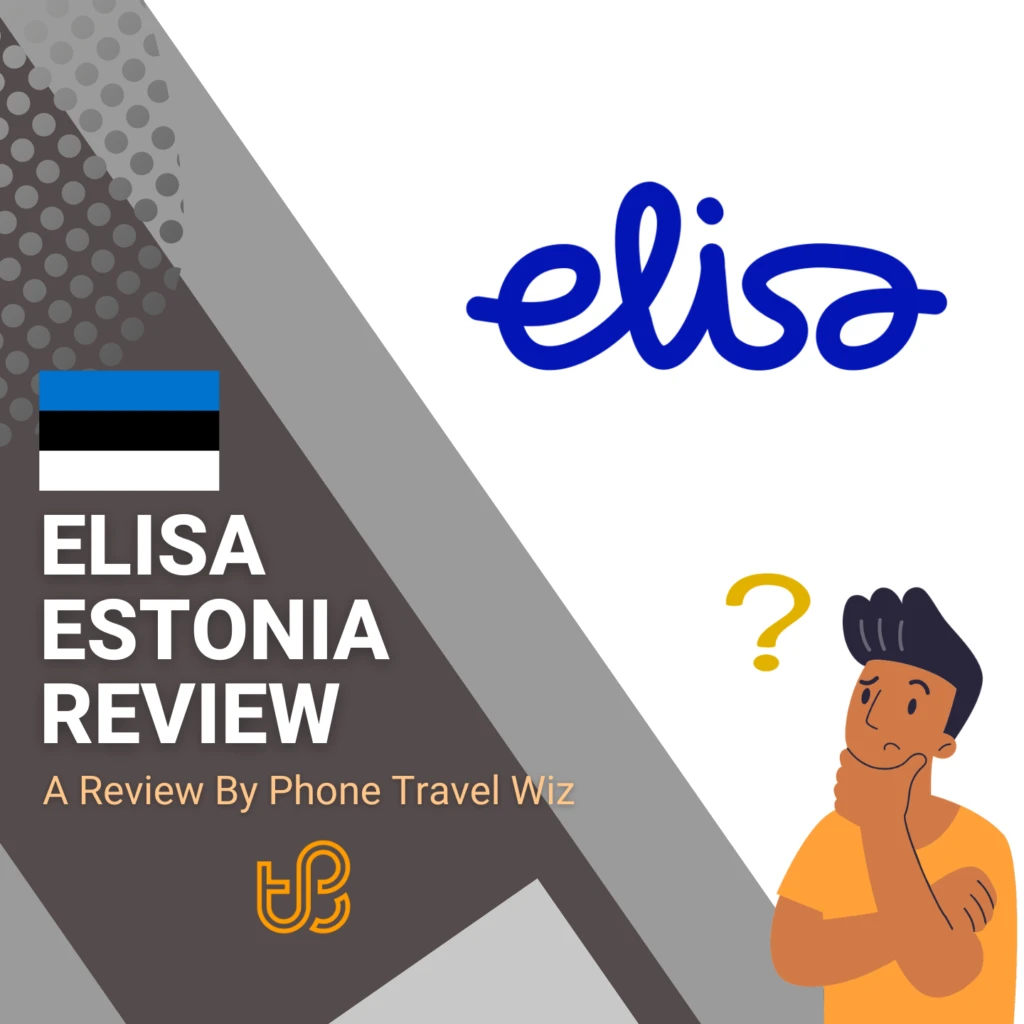
Original publication: 31st of January 2020. Last updated: 15th of January 2024.
Table of Contents
Telecom Providers in Estonia
Before I talk about Elisa, I need to inform you about your options in Estonia. If you have read my Buying a SIM Card in Estonia Guide, then you know that Estonia has 3 telecom providers: Telia Estonia, Tele2 Estonia, and Elisa Estonia. Every operator has 2 prepaid brands. In the case of Elisa Estonia, just Elisa from now on, they have Elisa and Zen.
Zen is the youth brand of Elisa. It is not a Mobile Virtual Network Operator (MVNO) using the Elisa network. Instead, it is just a brand with a different target group, meaning that data transmission from Zen will not be slower than Elisa.
Because of this, I decided to just go with Elisa, as there was no point in testing out two SIM cards from the same company. Zen has different combo packages than Elisa, which is the main difference between the two brands. Let’s see how Elisa did while I was in Tallinn.

Elisa is the second-largest operator in terms of subscribers. Often, the largest operator also has the best coverage and speeds in a country (and is usually the most expensive option too). However, in the case of Estonia, it does not matter with which operator you go with because the coverage with all operators is almost the same.
My Airbnb host, Edvard, told me that, unless you go to extremely rural Estonia, you will have a connection with all operators. In some remote places, only one or two operators may be active, but you will most likely not go there as a traveler.
How Do I Buy an Elisa Prepaid SIM Card?
You can buy Elisa SIM cards in official Elisa stores, in many supermarkets, from authorized resellers, and in kiosks called R-Kiosk. There are MANY kiosks in Tallinn. It looked like every street had at least an R-Kiosk, so you will not miss one.
There is an R-Kiosk at Tallinn Airport too. I did not buy my Elisa SIM card there because I wanted to visit an Elisa store just to see how they look like. It looks like everyone in Estonia speaks perfect English, so just saying SIM card will be fine when buying a SIM card at an R-Kiosk. If that does not work, Estonians call SIM cards Kõnekaart. If that is too hard to say, just show them this paragraph or the pictures below:
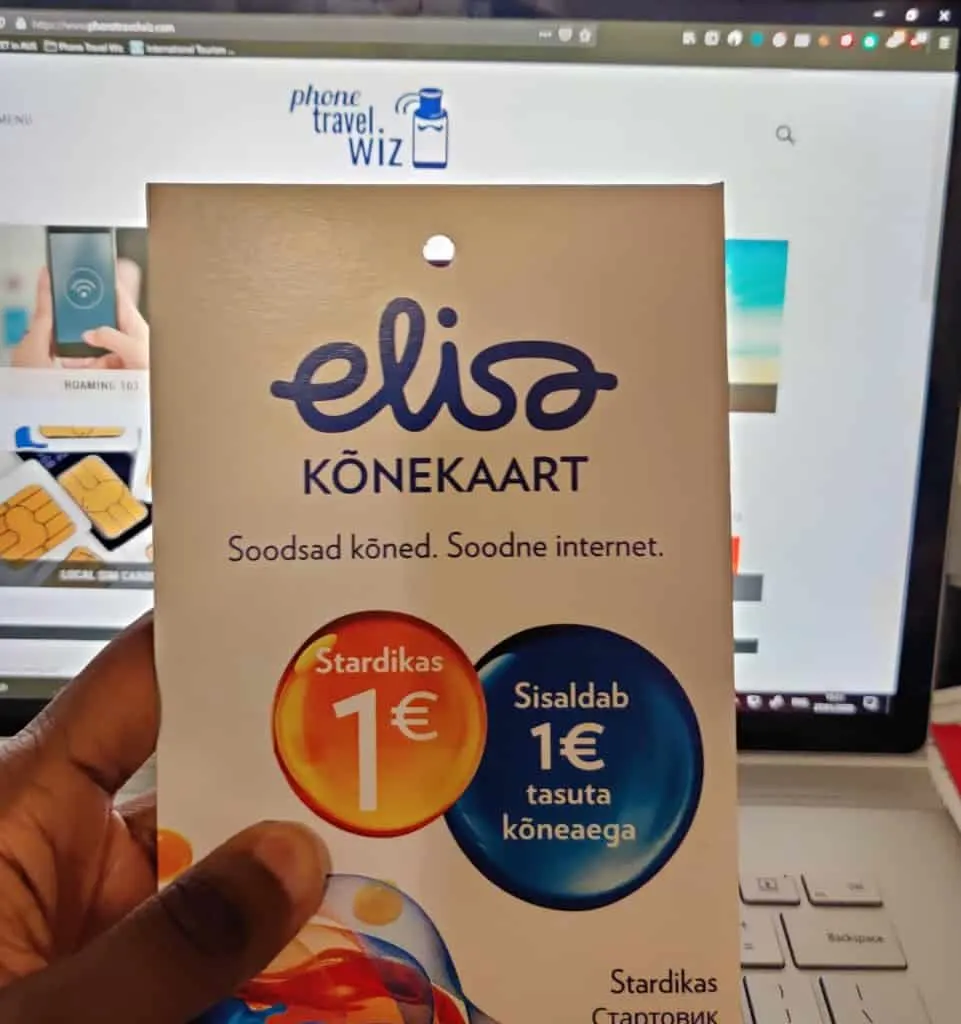
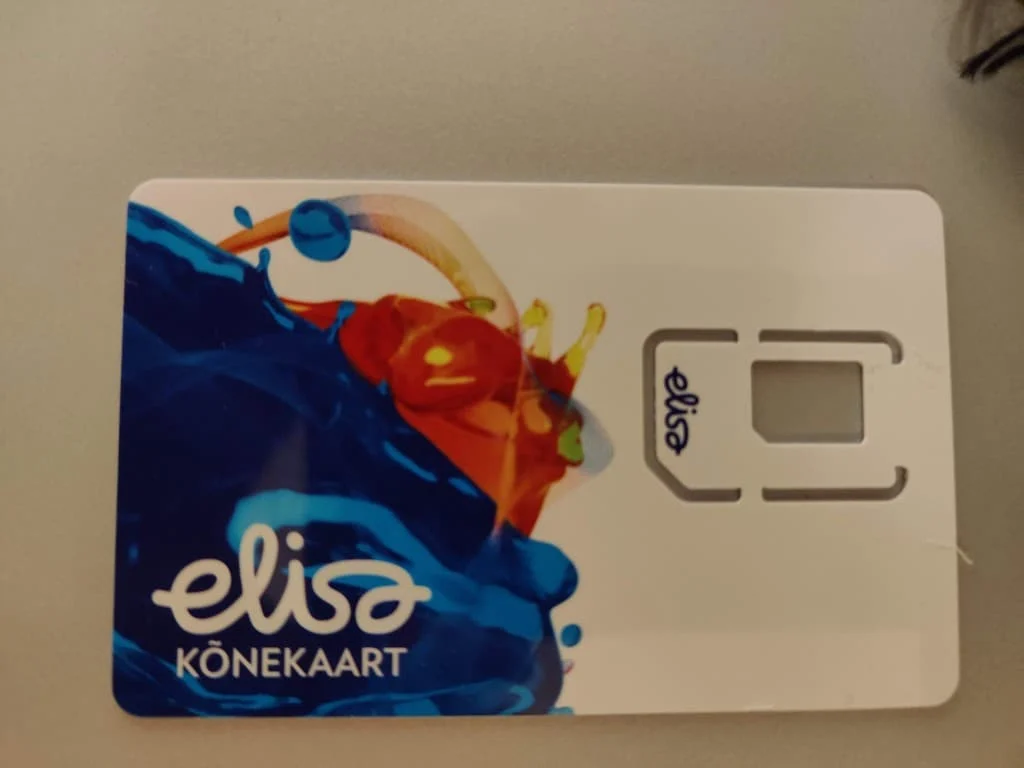
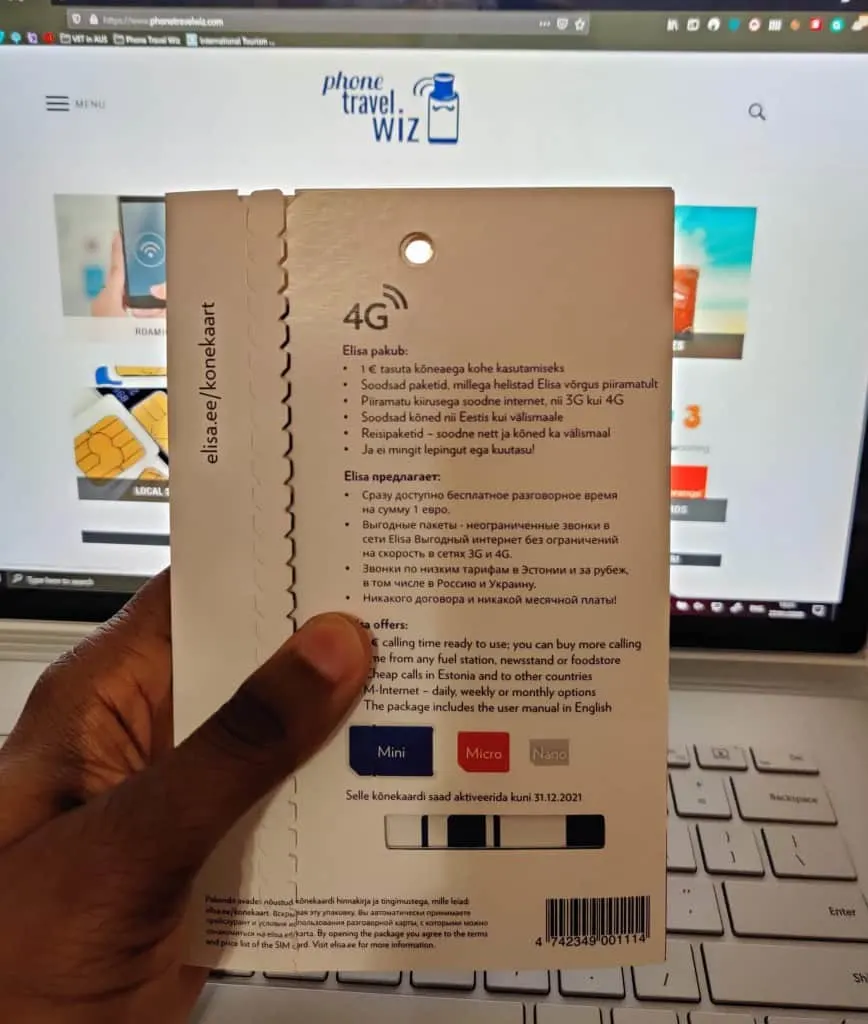
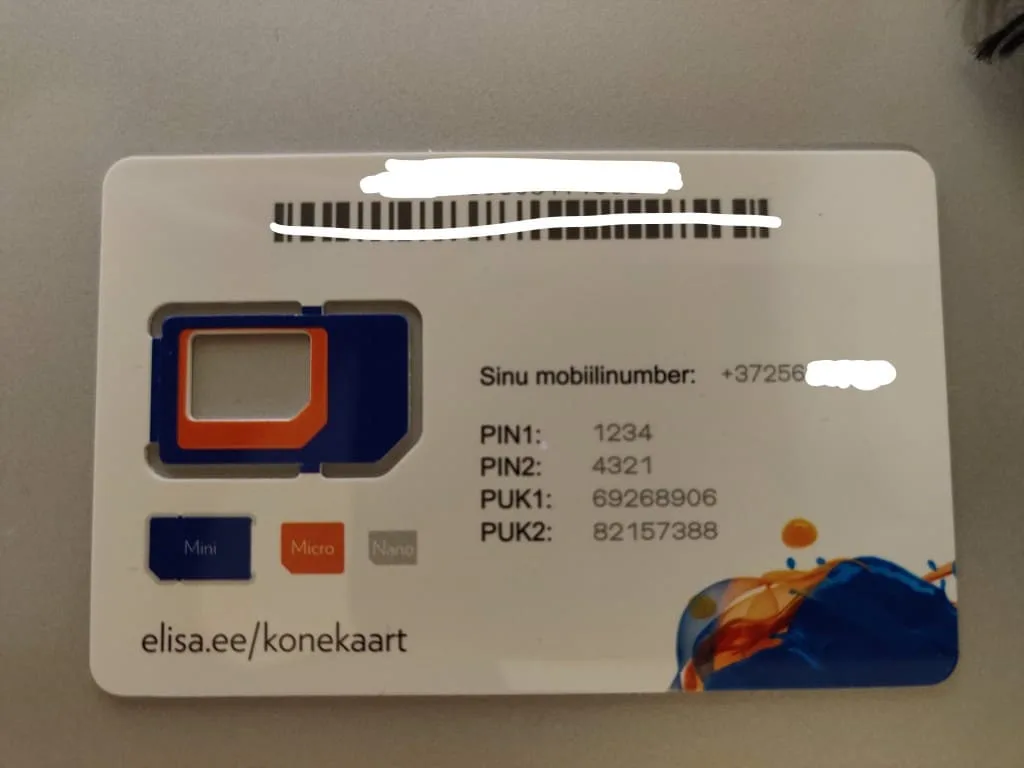
Unlike most countries in Europe, but like every other Baltic state, you do not have to show your passport when buying an Estonian SIM card, so you can buy your SIM card from the kiosk, activate it, and can get started.
In the Elisa store in the Viru Mall in Tallinn, the salesperson asked me whether I wanted an Elisa SIM card or a Zen SIM card. Although I knew the differences between the two, I asked her what the difference is, and she said there were no big ones. I told her to give me one, and she got me one from Elisa.
The SIM card itself costs a mere €1 and comes with €1 in credit. Standard data rates are €0.05 per 20 KB up to €1 for 400 KB. From there, you do not pay anything more until you have consumed 100 MB. Then your data will be shut down for the rest of the day.
How Do I activate my Elisa SIM card?
You need to activate your SIM card before you can top-up your card. A SIM card has to be activated by calling someone. In this case, I called the Elisa customer service line at 6 600 600 and ended the call as soon as I was connected. Now, you have successfully activated your Elisa SIM card.
How and Where Can I Top Up My Elisa SIM Card?
Recharge cards are sold in Elisa stores, Rimi and Maxima supermarkets, Prisma, R-Kiosks, Eesti Post (post offices), and various other stores. You can also top up online through the Elisa website. You can also do a bank transfer (SEPA), which is not recommended for most travelers. Either get a recharge voucher in a store or top-up online.
What Prepaid Packages Does Elisa offer?
The cheapest Elisa package called 4G day pass costs €1 and gives you 500 MB for 1 day. The most expensive data pack, the 4G month pass XL, costs €20 and comes with 25 GB for 30 days. I choose the €5 package called 4G week pass that gave me 2 GB for 7 days. I did not need much more data because I was trying out 3 different SIM cards (Super by Telia and Tele2), so I would have plenty of data for my short stay.
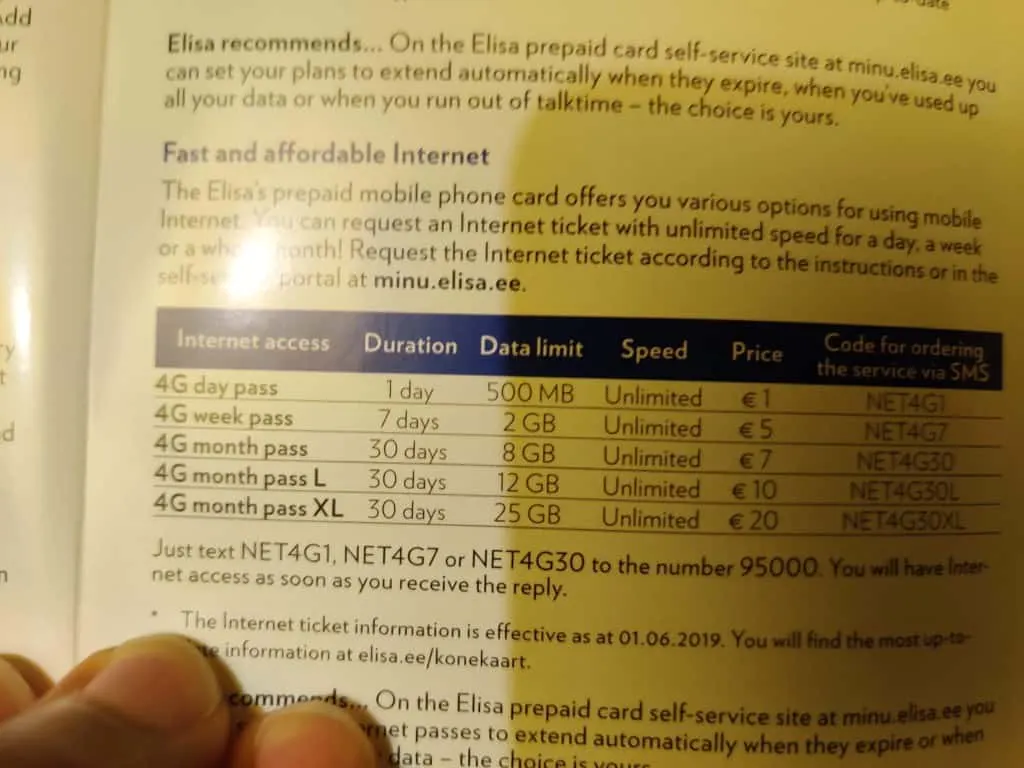
These are the packages promoted in the Elisa starter manual:
If you cannot see the image, the packages are shown in the table below:
| Price | Data | Duration | Activation code to 95000 |
| €1 | 500 MB | 1 day | NET4G1 |
| €5 | 2 GB | 7 days | NET4G7 |
| €7 | 8 GB | 30 days | NET4G30 |
| €10 | 12 GB | 30 days | NET4G30L |
| €20 | 25 GB | 30 days | NET4G30XL |
Do note that you can still use data after you have used up your allowance. However, your speed will be throttled to 2G speeds, which is annoyingly slow.
Besides these data plans, Elisa also has combo packs that include minutes and SMS to Estonian numbers:
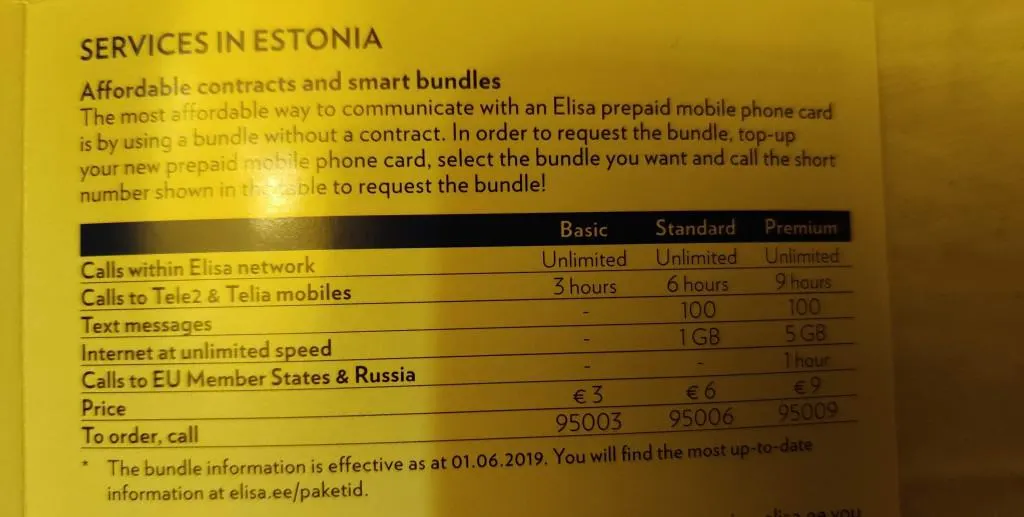
If you can not see the image, the combo packs are listed below:
- €3: Unlimited calls to Elisa numbers and 3 hours to Telia and Tele2 numbers (note: no data or SMS). Activation: call 95003
- €6: 1 GB, unlimited calls to Elisa numbers, 6 hours to Telia and Tele2 numbers, and 100 SMS. Activation: call 95006
- €9: 5 GB, Unlimited calls to Elisa numbers, 9 hours to Telia and Tele2 numbers, 1 hour to EU nation numbers and Russian numbers, and 100 local SMS. Activation: call 95009
What About Zen? What Do I Need to Know About Zen?
I discuss the youth brand of Elisa, Zen, in my Estonian SIM card buying guide. The main takeaway is that they have different packages than Elisa itself.
Can I Roam for Free with Elisa in the EU?
Be aware that none of Elisa’s prepaid packages can be used outside of Estonia. As of 2017, the roam like at home regulation became effective, meaning that operators in the European Union cannot charge roaming rates anymore or are required to give an EU roaming allowance. Because data rates are so low in Estonia, Estonian operators were given the option to opt-out from this scheme. Elisa did so, meaning that you cannot use your cheap allowances in other EU nations (for free). To roam with Elisa abroad, check out my Roaming with Elisa article covering the Elisa roaming options in-depth.
How do I activate an Elisa Data Plan?
When you buy your Elisa SIM card, the salesperson will ask you if you want to top up immediately, which you should. Unlike Telia that charges you a €1 administration fee for topping up in-store, Elisa does not charge you anything extra for their service, which is neat.
The salesperson will print your voucher code, which will look like this:
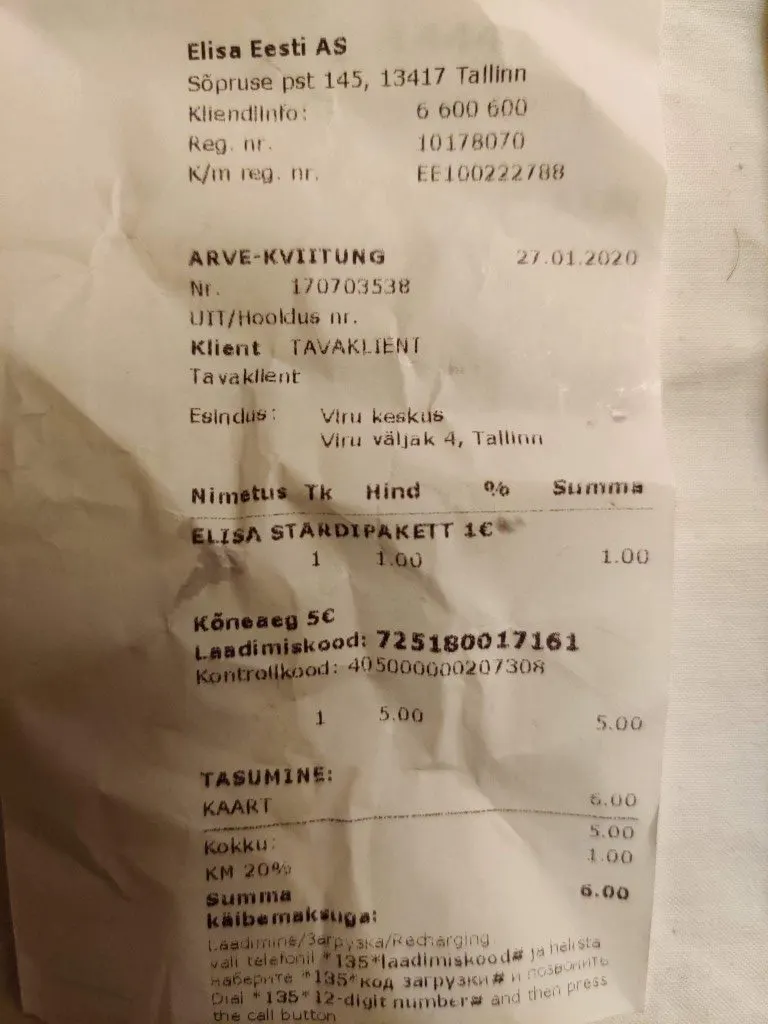
The voucher code is marked in bold called Laadimiskood. In my case, it was 725180017161. To top-up your Elisa SIM card, you dial *135*VOUCHER VODE#. In my case, it was *135*725180017161#. You then get a text message in Estonian saying that your recharge was successful (it mentions the top-up amount in the text. This way, you know it was done well).
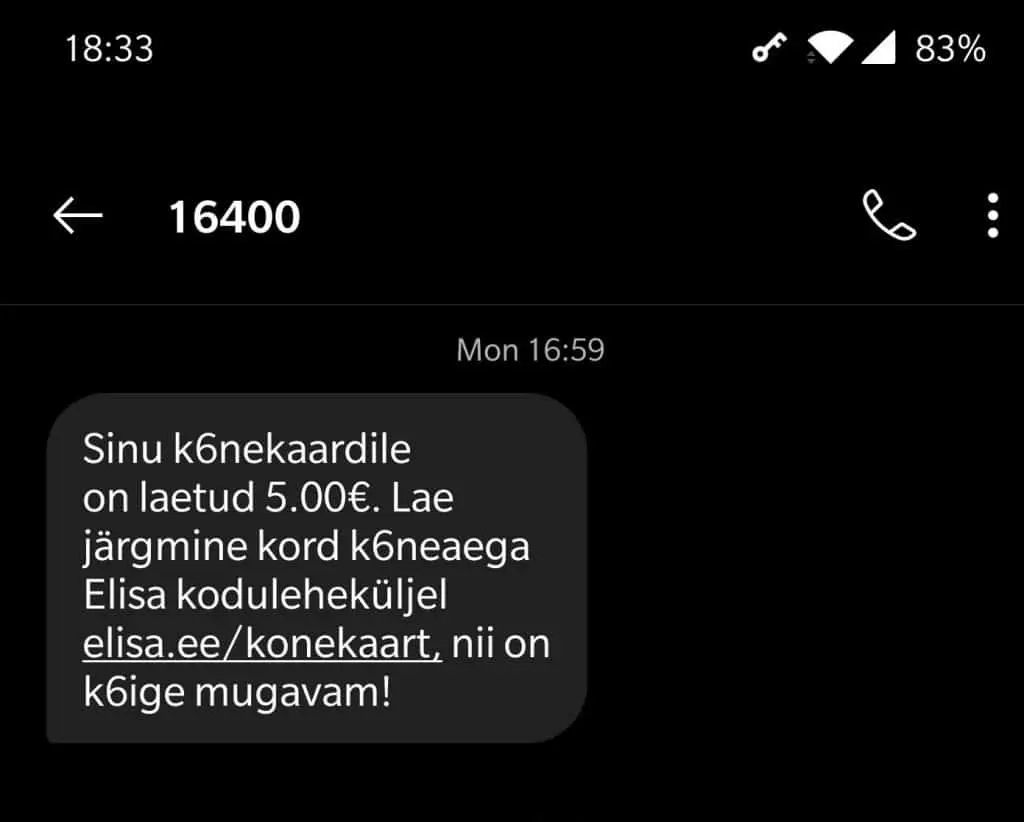
I showed the message to the salesperson too, just in case because I do not understand Estonian.
Tip: dial *135*923# or *135*723# to change operator messages from Estonian to English.
Now it was time to activate my preferred package, which was the €5 week pass with 2 GB. I texted NET4G7 to 95000. After a few seconds, I got the confirmation text saying that the package was activated and the expiry date and time (in Estonian).
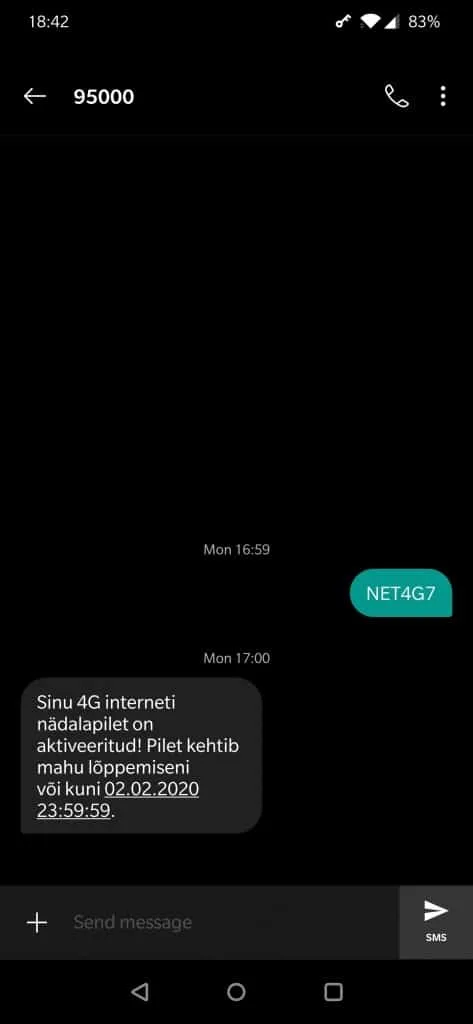
Success! You can now browse the web with your Elisa SIM card. If, for any reason, you cannot connect to the Elisa 4G/LTE, check whether your device is compatible with the frequencies and bands they use in Estonia (and most of Europe). This site will allow you to find out quickly, but Elisa uses the following frequencies and bands:
- 2G: 900 MHz and 1800 MHz
- 3G: 900 MHz and 2100 MHz
- 4G/LTE: 800 MHz, 1800 MHz, and 2600 MHz on Bands 3, 7, and 20.
In terms of topping up, you can also top up or buy data packs through the Elisa website. I used the voucher as shown above, so I cannot show you how to do everything online. However, as the Elisa website is in English (and Russian) as well, the process should be straightforward.
What Speeds Will I Get with Elisa in Estonia?
I did 3 speed tests in Tallinn: One at my Airbnb, one at the Viru mall where I bought my Elisa SIM card, and one at the airport. You can see the results below:
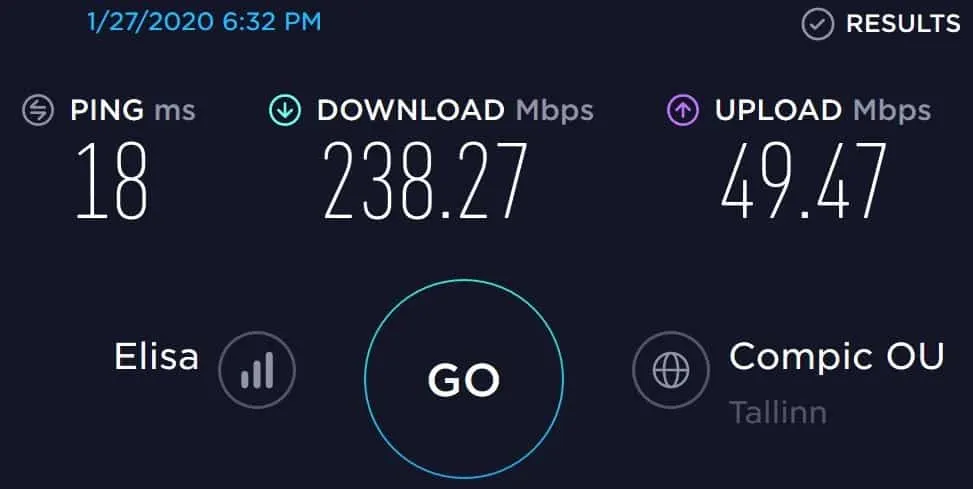
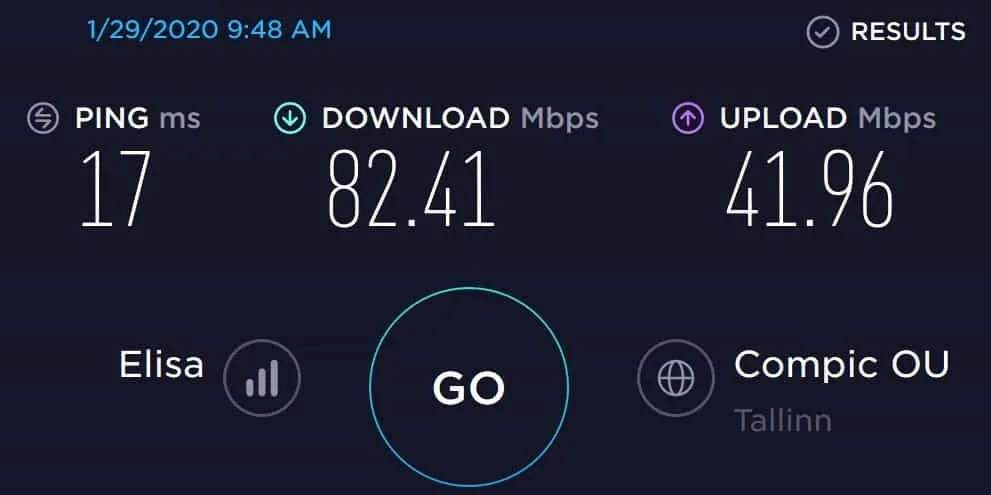
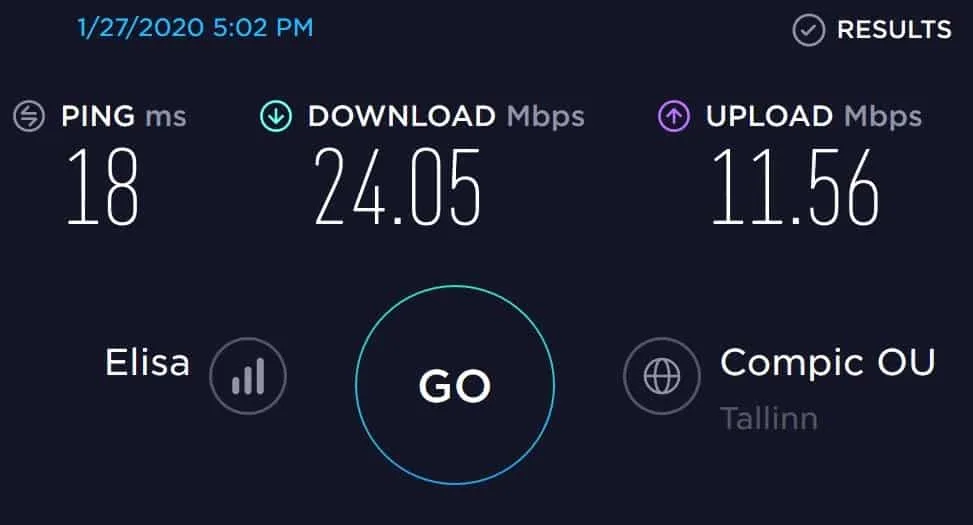
As you can see, speeds fluctuate depending on where you are. I was quite surprised to see such high speeds in my Airbnb apartment – I expected the speeds to be slower. The speed at the airport was also a pleasant surprise. The one from inside the mall was not a surprise, as it is a multi-level mall, and many people are around me.
Do I Recommend Elisa to Travelers Visiting Estonia?
I would recommend Elisa to those traveling to Estonia. In fact, I would recommend any Estonian operator because they are all similar in terms of coverage and speed. Speeds are affected by many factors, but Elisa did well in all settings.
Sure, I stayed in Tallinn, the capital of Estonia, meaning that my coverage and speeds will be much better than in rural Estonia, but many who visit Estonia go to Tallinn anyway (or any of the other bigger cities or towns), so your experience should be similar. Check out my Tele2 and Telia reviews as well!
Either way, I have got to love the speeds, coverage, and low data plans Estonian providers have to offer, including Elisa. You should have a good experience with Elisa.
How does Elisa Compare with Telia and Tele2?
Now that you know everything you need to know about Elisa, you may be wondering whether Elisa is the best for you or not. I made an Estonian SIM Card comparison article where I go through Elisa, Telia, and Tele2 more in-depth, comparing their packages, speeds, and coverage.
It is a good read where I take certain scenarios into account that may apply to you (such as spending a certain amount on data packages like €5, €10 and €20, wanting to roam within the EU, and speeds).
Be sure sure to check out the Best Estonian SIM Card comparison post.
The video above is a long video that goes over everything covered in the Best Estonian SIM Card comparison post. If you do not have that much time right now, add the video in your Watch Later playlist. For now, watch this video below that briefly introduces you to Elisa, Telia, and Tele2, and I do a speed test with them at the end.
